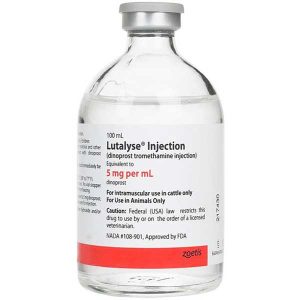I Gave My Mare Prostaglandin, But It Didn’t Work!
Hormones are commonly used in the mare to cause her to enter estrus (come in to “heat”), but sometimes prostaglandin fails to cause estrus. Let’s first look at how it should cause a return to estrus when it does work. Prostaglandin F2α – which may be endogenous (produced by the mare) or exogenous (given to the mare) – normally does this by destroying a structure that forms on the ovary following ovulation called the Corpus Luteum (“CL”)1. The CL secretes the hormone progesterone, which prevents the mare from displaying receptivity to a stallion. This destructive process may seem a little radical, but in fact the mare herself will secrete prostaglandin F2α from her endometrium (the lining of the uterus) about 14 days after her previous ovulation if she is not pregnant2 with the same effect – destruction of the CL (called “luteolysis”), and a resulting return to estrus.
From the above, we can clearly see that for prostaglandin F2α to bring a mare back into estrus, there must be a CL present on the ovary that is receptive to the action. Such a CL will typically only be present at least 5 days after an ovulation has occurred. In other words, the administration of prostaglandin F2α sooner than 5 days after an ovulation, or in the absence of an ovulation (such as during transitional phase before the first ovulation of the year) will mean that prostaglandin fails to cause estrus.
It would seem reasonable then, that we should detect an ovulation on a prior cycle, count to at least day 6, give the prostaglandin F2α and then expect to see the mare come back into estrus, right? Wrong!
Mares have the ability to develop follicles, and indeed ovulate follicles, in the face of elevated progesterone levels – i.e. during diestrus (the time in between “heat”) or pregnancy. This is perfectly normal, and although not seen in all mares, can lead to a failure of timely luteolysis, and – consequently – no return to estrus. In other words, even if you have faithfully counted the requisite 6 days from the previously identified ovulation, but the mare has recently ovulated a second (undetected) follicle, the prostaglandin fails to cause estrus.
The next issue that can cause problems when using prostaglandin F2α in an attempt to induce estrus is that – assuming there is a receptive CL present – the duration to the onset of estrus will be significantly impacted by the size of the follicles present on the ovaries at the time of treatment3. If a follicle >2 cm in diameter is present at the time the prostaglandin F2α is administered, rapid onset and ovulation may occur. With follicles >2 but <3 cm average diameter, this may happen in as little as 2-4 days, although with follicles >3 cm in diameter, ovulation may occur within 24 hours4,5 (and occasionally less). If the follicles are <2 cm in diameter at the time of treatment, ovulation will on average occur about 7½-9½ days later6. Another possible problem to be faced when dealing with a mare with a >3 cm in diameter follicle present is that in some cases, there will not be a rapid onset of estrus and ovulation, but rather a regression of the follicle, with a delayed onset of estrus.
It should also be noted that in mares that have a rapid onset of estrus and short interval to ovulation following the use of prostaglandin F2α, a reduced (50% of the second group) embryo recovery rate was seen when compared to mares treated with <3 cm diameter follicles present and which had a normal interval to ovulation6.
While the use of prostaglandin F2α may be an easy way to induce estrus, it is not without considerable complications that are often not understood and which can result in failure. In order to successfully induce a timely estrus, it is therefore essential to be fully conversant with what structures are present on the mare’s ovaries at the time of treatment, and how large they are. It is of course equally essential to treat the mare in a manner suitable based upon those findings.
As an aside from the subject of why prostaglandin fails to cause estrus, let us look at another aspect which often comes into conversation around the use of the hormone in the mare – side effects. It is common that when a full dose of prostaglandin is given to the mare, regardless of estrous stage, CL presence, or follicular diameter, the mare will shortly after – usually 5-15 minutes – start to sweat and may show signs of abdominal cramping. A “full dose” of most products is usually by volume, 1 to 2 ml. In the case of Dinoprost products (e.g. “Lutalyse”, “Prostamate” etc.) this equates to 5 to 10 mg, while in the case of Cloprostenol (“Estrumate”) it is 250-500 micrograms. As far back as 1975, Douglas et al determined that “A single subcutaneous injection of 1.25 mg PGF2α on Day 6 of dioestrus was as effective as 10 mg PGF2alpha in inducing luteolysis.”7 This was reconfirmed by Irvine et al in 2002 who observed “Two doses of 0.5 mg PGF2alpha 24 h[ours] apart caused lysis of the corpus luteum in all mares [in the research group]”.8 Douglas’s dosage would have equated to 0.25 ml of Dinoprost, and Irvine’s to 0.1 ml at current concentrations of popular products. Both of these pieces of research indicated a lack of the unpleasant side-effects at these dosages. Other researchers have found that a similar reduction to one-tenth the “full” dosage of Cloprostenol also results in a timely return to estrus without unpleasant side-effect. The efficacy of these reduced dosages of both products does however rely upon the other factors described in the article being either present or absent as the case may be.
Summary:
- For success, the mare cannot be in a state of anestrous (winter or otherwise), or still in transitional phase (i.e. prior to the first ovulation of the year), If she is, then prostaglandin fails to cause estrus;
- For prostaglandin F2α to induce estrus, there must be a fully functional CL present;
- This is generally achieved by making sure the previous ovulation occurred at least 6 days prior to treatment.
- There cannot have been a recent (<6 days), possibly undetected ovulation;
- Follicles – if present – should be <3cm in diameter (and preferably <2 cm);
- If the onset of estrus occurs rapidly, it is likely that ovulation will also occur rapidly.
- Teasing should be started the day of, or the day after, administration of prostaglandin F2α, with immediate breeding if a rapid onset of estrus is detected.
- If prostaglandin F2α is given to a mare with follicles >3 cm, the resulting pregnancy rate will be decreased if rapid ovulation is seen.
- Using one-tenth of the full dosage volume either once (Cloprostenol) or two days in a row (Dinoprost) will cause a return to estrus in receptive mares without the unpleasant side-effects often seen with usage of the full dosage (sweating, cramping etc.)
Commercial brand-name prostaglandin F2α or prostaglandin F2α analogue products include:
Lutalyse (Pharmacia and Upjohn Company, Kalamazoo, MI)
Prostamate (Phoenix Pharmaceutical, Inc St. Joseph, MO)
Estrumate (Schering-Plough Corporation Kenilworth, NJ) – not labeled for use in horses.
References:
1: Silvia WJ, Lewis GS, McCracken JA, Thatcher WW, Wilson JR. (1991) Review: hormonal regulation of uterine secretion of prostaglandin F2a during luteolysis in ruminants. Biol. Reprod.; 45:655-63
2: Douglas, RH, Ginther, OJ. 1976. Concentration of prostaglandin F in uterine venous plasma of anaesthetised mares during estrous cycle and early pregnancy. Prostaglandins; 11:251-60
3: Loy RG, Buell JR, Stevenson W, Hamm D. 1979. Sources of variation in response intervals after prostaglandin treatment in mares with functional corpora lutea. J Reprod. Fertil. Suppl.; 27:229-35
4: Kiefer BL, Roser JF, Evans JW, Neely DP, Pachero CA. 1979. Progesterone patterns observed with multiple injections of a PGF-2 alpha analogue in the cyclic mare. J Reprod. Fertil. Suppl.; 27:237-44
5: Personal observation
6: Lindenburg H, Koskinen E, Huhtinen M, Reilas T, Perttula H, Katila T. 2002. Influence of PG administration and follicle status on the number of conceptuses. Theriogenology 58, 571-574.
7: Douglas RH, Ginther OJ. 1975. Effects of prostaglandin F2alpha on the oestrous cycle and pregnancy in mares; J Reprod Fertil Suppl. 23:257-61.
8: Irvine CHG, McKeough VL, Turner JE, Alexander SL, Taylor TB. 2002. Effectiveness of a two-dose regimen of prostaglandin administration in inducing luteolysis without adverse side effects in mares. Equine Vet J 342:191-4.
© 2005, 2021, 2022, 2024 Equine-Reproduction.com, LLC
Use of article permitted only upon receipt of required permission and with necessary accreditation.
Please contact us for further details of article use requirements.
Other conditions may apply.




